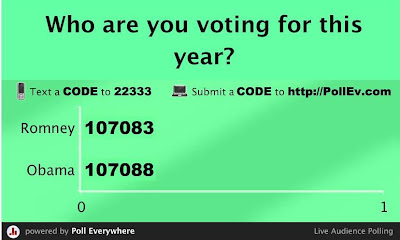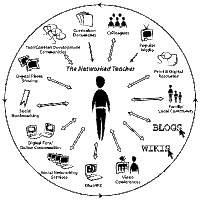This Is How We Dream - Parts 1 and 2
Dr. Miller says that we are living in one of the greatest times of change in communication. He makes the point that with the internet we constantly have access to information, however, in a library, if someone checks out a book, that book is inaccessible until it is returned. Most of us grew up with paper books, and in only the past few years books have gone electronic. The new technologies that are merging their way through our society are very promising and will greatly enhance the way our students learn. Dr. Miller also points out that the internet has given us the tools to work in great distances from other people and still come to the same point, or end goal. People no longer how to travel to meet their partners. They can do everything that they need to via the internet. This means that teachers can collaborate with other teachers from around the world
to create better lesson plans and strategies. Students can learn from other students from different schools.
In Part 2 of this series, Dr. Miller states how our methods of research have changed. It could takes weeks to years for updated material to reach the libraries shelves, however, information on the internet is updated almost every day if not every second. The internet is more reliable due to the fact that it can be changed so easily. Unfortunately, some schools feel that they don't have "room" to teach classes based on this. I feel that if we could teach students these things at an early age then they could make a huge difference in the future. As teachers, we need to take the initiative to broaden the horizons of our students and show them the possibilities that are out there. We put limitations on ourselves and we have the power to take them away.
Carly Pugh - Blog Post #12
Carly did an excellent job with this post. It is a very creative assignment and provides a lot of freedom in the work space. With this assignment, I can express myself and my teaching philosophies through video. It's kind of like having a playlist of music that describes your mood, but instead it's videos that describe your goals and thoughts on teaching. Carly demonstrates Dr. Miller's hopes for writing with multi-media by being creative and using the unlimited resources on the web to teach something not only to herself, but to others. She is going to be more than capable of adapting to the changing society.
I never thought about all of the possibilities that were out there with YouTube, because like others, I was narrow minded to the use of an abundance of technology in the classrooms. This post was definitely an eye opener!
The Chipper Series
EDM310 for Dummies
These videos made some very good points. The Chipper Series tells a story of a student who dropped out of college because it was to hard and time consuming. She ended up working as a garbage collector. Stories like this happen more than I would like to imagine. Students think that the problem is the school or the professor, but the true problem is within the student. In order to be an effective student, you need to be able to follow the instruction of a teacher. Getting your degree isn't going to be a piece of cake. You actually have to work at it. These two videos made me think of a video that I would like to create explaining how YouTube can change your life. So many videos that I've watched in this class have changed my opinion of things. I want people to know that whatever your searching for in your life, there is probably video talking about or showing someone going through the exact same thing... or worse. YouTube is a wonderful website for soul searching.
Learn to change, change to learn
This video talks about the importance of change in our school systems. Students need to learn to work with the upcoming technologies instead of staying in the old ways of memorizing facts and spitting them onto a test paper. They need to know how to find those facts on the web, make sure they're legitimate, and learn how to communicate it. One of the speakers proclaimed that, "Technology is not a choice." This is a very true statement. We now have technology like smart phones and iPads. We could show students how to use these things educationally. We could teach them about communication, not only across the city,county, or country, but across the world. In doing this we open our students to new opportunities and allow them to learn about other cultures and activities of kids their own age. Learning shouldn't solely be about education, but about building a community and new relationships.Half of the things that I learned in high school were put in my short term memory for the next test and then forgotten. This isn't going to help me now that I'm in college and searching for a job. It hasn't prepared me at all. This new way of teaching will help prepare students for the future. The people in the video talk about students that are coming from these new programs are coming out smarter and braver. This is what we need to install in ALL students.
Web 2.0 Scavenger Hunt
MakeBeliefsComix
Animoto
Animoto.com is a video tool that let's you create a video using your photos, video clips, and music. Their description says that it is, "Fast, Free, and Shockingly Easy". You start off by adding your photos or video clips to the sight. They can come from your computer or off the web. Next, you would add music. They have hundreds of songs in their music collection, but you can add your own mp3 if you want to. There are several different video styles that can help to spice up your production. The website states that,
"There’s an Animoto style for every story, event, or theme". Your video also has that option of being High Resolution and Cinematic. This means that your video can have the same look and quality as a movie!Once your video is made, you can share it anywhere! You can put your creation on Facebook, Youtube, Twitter, and others. You can also use Animoto on your mobile device. You can create videos on the go! This is a great site for teachers and students. It's very easy to use and would be great in classroom settings.
PollEverywhere






